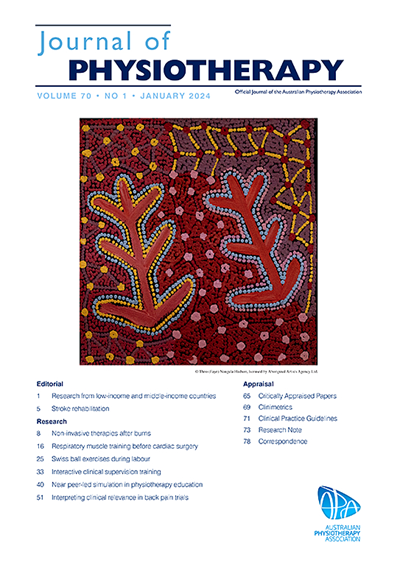The smallest worthwhile effect of surgery versus non-surgical treatments for sciatica: a benefit-harm trade-off study
IF 9.7
1区 医学
Q1 ORTHOPEDICS
引用次数: 0
Abstract
Question
What is the smallest worthwhile (SWE) effect of discectomy compared with non-surgical treatments amongst people with sciatica?
Design
Benefit-harm trade-off study.
Participants
People with sciatica of any duration living in Australia and recruited through social media.
Outcome
The outcome of interest was leg pain intensity. Participants were asked to nominate the additional percentage reduction in leg pain from discectomy––above the reduction anticipated from non-surgical treatments––that would make discectomy worthwhile for them. The SWE was estimated as the median (IQR) of the smallest percentage reduction in leg pain with discectomy (compared with non-surgical treatment) that participants considered worthwhile. The SWE was estimated for the overall sample and those with acute (≤ 6 weeks), subacute (> 6 to 12 weeks) and chronic (> 12 weeks) sciatica, and investigated factors associated with the SWE.
Results
Two hundred participants with a mean age of 59 years (SD 12) were included. The SWE was estimated to be an additional 15% (IQR 10 to 40) reduction in leg pain with discectomy, beyond any reduction in leg pain achieved by non-surgical treatments. Dissatisfaction with previous non-surgical treatments and low pain self-efficacy were associated with smaller SWE estimates.
Conclusion
People with sciatica would require discectomy to provide an additional 15% reduction in their leg pain beyond the expected 50% improvement in leg pain from non-surgical treatments in the short term to consider discectomy worthwhile. These results can inform the interpretation of the effects of discectomy in randomised trials and meta-analysis from the perspective of consumers.
坐骨神经痛手术治疗与非手术治疗的最小有价值效果:一项利弊权衡研究。
问题:与非手术治疗相比,椎间盘切除术对坐骨神经痛患者的最小价值(SWE)效果是什么?设计:利弊权衡研究。参与者:居住在澳大利亚并通过社交媒体招募的任何时间的坐骨神经痛患者。结果:关注的结果是腿部疼痛强度。参与者被要求说出椎间盘切除术对腿部疼痛的额外减少百分比——高于非手术治疗预期的减少百分比——这将使椎间盘切除术对他们来说是值得的。SWE被估计为参与者认为值得的椎间盘切除术(与非手术治疗相比)腿部疼痛最小百分比减少的中位数(IQR)。评估了所有样本以及急性(≤6周)、亚急性(> 6 ~ 12周)和慢性(> 12周)坐骨神经痛患者的SWE,并研究了与SWE相关的因素。结果:纳入200名平均年龄59岁(SD 12)的参与者。据估计,椎间盘切除术后腿部疼痛的SWE减少了15% (IQR为10 - 40),超过了非手术治疗的任何腿部疼痛减少。对以前非手术治疗的不满意和低疼痛自我效能与较小的SWE估计相关。结论:坐骨神经痛患者需要椎间盘切除术来提供额外15%的腿部疼痛减少,而非手术治疗在短期内预期的腿部疼痛改善为50%,以考虑椎间盘切除术是值得的。这些结果可以从消费者的角度解释随机试验和荟萃分析中椎间盘切除术的影响。
本文章由计算机程序翻译,如有差异,请以英文原文为准。
求助全文
约1分钟内获得全文
求助全文
来源期刊

Journal of Physiotherapy
ORTHOPEDICS-REHABILITATION
CiteScore
11.40
自引率
7.40%
发文量
69
审稿时长
72 days
期刊介绍:
The Journal of Physiotherapy is the official journal of the Australian Physiotherapy Association. It aims to publish high-quality research with a significant impact on global physiotherapy practice. The journal's vision is to lead the field in supporting clinicians to access, understand, and implement research evidence that will enhance person-centred care. In January 2008, the Journal of Physiotherapy became the first physiotherapy journal to adhere to the ICMJE requirement of registering randomized trials with a recognized Trial Registry. The journal prioritizes systematic reviews, clinical trials, economic analyses, experimental studies, qualitative studies, epidemiological studies, and observational studies. In January 2014, it also became the first core physiotherapy/physical therapy journal to provide free access to editorials and peer-reviewed original research. The Australian Physiotherapy Association extended their support for excellence in physiotherapy practice by sponsoring open access publication of all Journal of Physiotherapy content in 2016. As a result, all past, present, and future journal articles are freely accessible, and there are no author fees for publication.
 求助内容:
求助内容: 应助结果提醒方式:
应助结果提醒方式:


